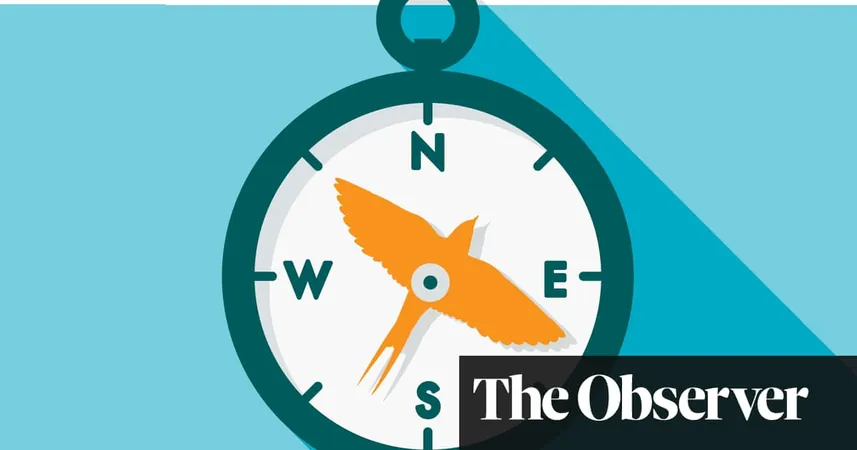
Unlocking Nature's Secrets: How Migrating Birds Master Quantum Navigation!
2025-03-23
Author: Yan
Introduction
As spring approaches, and the sound of the chirping chiffchaffs and wheatears fills the air, one can’t help but feel mesmerized by the annual return of migrating birds from their winter retreats. These remarkable creatures embark on daunting journeys, some spanning thousands of kilometers, returning to their breeding grounds with astonishing accuracy, often landing within centimeters of where they started. While we typically envision grand flocks of geese and elaborate starling murmurations, the truth is far more intriguing—most migratory birds, as noted by Miriam Liedvogel of Germany's Institute of Avian Research, travel solo during the night, navigating vast distances without the guidance of others.
The Mystery of Migratory Navigation
This fascinating ability has perplexed scientists for centuries, with philosophers like Aristotle once speculating whimsically about species transformations among birds during migration. However, with modern research, we've dispelled many outdated notions, such as the idea of birds changing species over seasons. Current understanding shows that an impressive 95% of migratory birds embark on their journeys alone at night, suggesting that their navigational skills are an inherited trait.
Quantum Mechanics and Navigation
Incredibly, these avian travelers leverage Earth's magnetic field to ensure they stay on course. The key to unlocking this ability may lie in the realm of quantum mechanics. Pioneering biophysicist Klaus Schulten, alongside colleagues, proposed a theory in the late 1970s regarding how birds could sense magnetic fields at a molecular level. The mechanism involves free radicals—pairs of unpaired electrons formed when molecules absorb energy. These radicals exhibit unique behaviors sensitive to magnetic fields, enabling birds to steer themselves effectively during migration.
Cryptochrome 4 and Its Role
Further developments in recent years have pointed to a critical protein known as cryptochrome 4, found in the eyes of migratory birds, as a potential player in this magnetic sensing game. Recent studies have highlighted how these proteins interact with light, kicking off the essential radical pair mechanism. In 2021, researchers demonstrated that robins possess a heightened sensitivity to magnetic fields compared to non-migratory species like chickens, suggesting that this protein is central to navigation.
Genetic Insights
Moreover, genetic studies reveal interesting insights into the evolution of these proteins. Liedvogel and her team investigated variations in cryptochrome proteins across different bird species, uncovering that while stable proteins are crucial for survival, cryptochrome 4 shows significant variations, possibly indicating that it has adapted to meet the unique navigational demands of migratory species. Yet, there's still mystery surrounding certain groups of birds lacking cryptochrome 4—behavioral experiments are underway to understand how these species navigate without it.
Quantum Limits and Urban Noise
Excitingly, the limits of this migratory precision might be rooted in the principles of quantum mechanics. Iannis Kominis from the University of Crete emphasizes that the Heisenberg uncertainty principle imposes a fundamental constraint on how sensitive these biological mechanisms can be—an obstacle that reflects the intricate balance of energy exchanges necessary for precise measurements in life.
Research Developments
In groundbreaking studies, researchers have explored how urban electromagnetic noise can disorient birds, shedding more light on their remarkable quantum navigation abilities. The implementation of quantum calculations has allowed scientists to predict how these avian navigators respond to fluctuations in magnetic fields, confirming a sophisticated and delicate connectedness between their quantum sensing mechanisms and the environment.
Conclusion
As researchers continue to unearth the mysteries behind avian navigation, one thing is becoming increasingly clear: birds are not only masters of migration but also extraordinary quantum sensors operating within the chaos of nature. Their ability to employ quantum mechanics for navigation challenges our understanding of intelligence in the animal kingdom. The term "bird brain," once an insult, now seems to carry a whole new weight of admiration. Let’s celebrate the marvels of nature and ponder what other secrets await discovery in the animal world!



 Brasil (PT)
Brasil (PT)
 Canada (EN)
Canada (EN)
 Chile (ES)
Chile (ES)
 Česko (CS)
Česko (CS)
 대한민국 (KO)
대한민국 (KO)
 España (ES)
España (ES)
 France (FR)
France (FR)
 Hong Kong (EN)
Hong Kong (EN)
 Italia (IT)
Italia (IT)
 日本 (JA)
日本 (JA)
 Magyarország (HU)
Magyarország (HU)
 Norge (NO)
Norge (NO)
 Polska (PL)
Polska (PL)
 Schweiz (DE)
Schweiz (DE)
 Singapore (EN)
Singapore (EN)
 Sverige (SV)
Sverige (SV)
 Suomi (FI)
Suomi (FI)
 Türkiye (TR)
Türkiye (TR)
 الإمارات العربية المتحدة (AR)
الإمارات العربية المتحدة (AR)